Articles
- Page Path
- HOME > Korean J Community Nutr > Volume 16(1); 2011 > Article
-
Original Article
- A Study on Body Image Perception and Eating Disorders by Birth-Place and the Length of Residence in USA in Korean American College Students
- Ho Kyung Ryu, Isobel R. Contento
-
Korean Journal of Community Nutrition 2011;16(1):113-125.
DOI: https://doi.org/10.5720/kjcn.2011.16.1.113
Published online: February 28, 2011
Department of Food and Nutrition, Pusan National University, Pusan, Korea.
1Department of Health and Behavior Studies, Teachers College, Columbia University, New York, USA.
- Corresponding author: Ho Kyung Ryu, Department of Food and Nutrition, Pusan National University, Jangjun-dong, Geumjung-gu, Pusan 609-735, Korea. Tel: (051) 510-7397, Fax: (051) 583-3648, hokryu@pusan.ac.kr
Copyright © 2011 The Korean Society of Community Nutrition
- 936 Views
- 3 Download
- 6 Crossref
Abstract
- This study was conducted to compare the body image perception, weight control experiences and the eating disorders according to where they were born, and the length of residence in USA among Korean-American college students. Three hundred college students participated in the study: 144 males and 156 females, 122 America-born (AB) and 171 Korea-born (KB) who live in New York City and New Jersey. Subjects responded to a self-administered questionnaire. The results showed that the ratio of overweight (23.2%) and obesity (26.8%) of males was higher than females' (16.1% and 6.3%, respectively). There were no significant differences according to born-place or the length of residence in USA of KB. People who had tried to control their weight were 58%. The ratio of weight control experiences of females (72.4%) was higher than males' (42.4%) as well as people who were normal or underweight than who were overweight or obesity. There were no significant differences according to born-place or the length of the residence in the USA of KB. In body image perception, the subjects who were normal and underweight overestimated their body figure, and the subjects who were overweight and obese underestimated their body figure. The desired and ideal figure of female students was significantly thinner than the current figure and also that of male students. There were no significant differences according to born-place or the length of the residence in USA of KB. The ratio of eating disorder was 8.7%, and females had higher percentage than males. And shorter they lived in USA, the percentage of eating disorder was higher.
-
This research was supported by the Financial Supporting Project of Long-term Overseas Dispatch of PNU's Tenure-track Faculty, 2006.
NOTES
- 1. Abrams K, Allen L, Gray J. Disordered eating attitudes and behaviors psychological adjustment, and ethnic identity : a comparison of black and white female college students. Int J Eat Disord. 1993; 14: 49-57.ArticlePubMed
- 2. Akan GE, Grilo CM. Sociocultural influences on eating attitudes and behaviors, body image, and psychological functioning: a comparison of African-American, Asian-American, and Caucasian college women. Int J Eat Disord. 1995; 18(2): 181-187.ArticlePubMed
- 3. Attie I, Brooks-Gunn J. Development of eating problems in adolescent girls : A longitudinal study. Dev Psychol. 1989; 25(1): 70-79.Article
- 4. Bailey S, Goldberg JP. Eating patterns and weight concerns of college women. J Am Diet Assoc. 1989; 89(1): 95-96.ArticlePubMed
- 5. Berg FM. The Healthy People 2010 approach to eating disorders and obesity: An evaluation. Healthy Weight J. 2001; 15(1): 8-9.
- 6. Bresolin L. Body Image and health counseling for women. Arch Fam Med. 1993; 2: 1084-1087.ArticlePubMed
- 7. Chin YS, Taib MN, Shariff ZM, Khor GL. Development of multi-dimensional body image scale for malaysian female adolescents. Nutr Res Pract. 2008; 2(2): 85-92.ArticlePubMedPMC
- 8. Choi MS, Cheon SH. Internalization of the socio-cultural attitudes, body shape satisfaction, anger and eating attitudes in college women. Korean J Women Health Nurs. 2007; 13(4): 327-335.ArticlePDF
- 9. Contento IR, Basch C, Zybert P. Body image, and food choices of Latina women and their young children. J Nutr Educ Behav. 2003; 35: 236-248.PubMed
- 10. Davis C, Katzman MA. Perfection as acculturation : psychological correlates of eating problems in Chinese male and female students living in the United States. Int J Eat Disord. 1999; 25: 65-70.ArticlePubMed
- 11. Desai MN, Miller WC, Staples B, Bravender T. Risk factors associated with overweight and obesity in college students. J Am Coll Health. 2008; 57(1): 109-114.ArticlePubMed
- 12. Despres JP, Lemieux I, Almeras N. In: Bray GA, Ryan DH, editors. Abdominal obesity and the metabolic syndrome. Overweight and the metabolic syndrome: from bench to bedside. 2006; NY: Springer; 137-152.
- 13. Desmond S, Price J, Hallinan C, Smith D. Black and white adolescents' perception of their weight. J School Health. 1989; 59: 353-358.PubMed
- 14. Fallon AE, Rozin P. Sex differences in perceptions of desirable body shape. J Abnorm Psychol. 1985; 94(1): 102-105.ArticlePubMed
- 15. Furnham A, Alibhai N. Cross-cultural differences in the perception of female body shapes. Psychological Medicine. 1983; 13: 829-837.ArticlePubMed
- 16. Garner DM, Olmsted MP, Bohr Y, Garfinkel P. The eating attitudes test: psychometric features and clinical correlates. Psychological Medicine. 1982; 12: 871-878.ArticlePubMed
- 17. Gordon BH, Kang MS, Cho P, Sucher KP. Dietary habits and health beliefs of Korean-Americans in the San Francisco Bay area. J Am Diet Assoc. 2000; 100: 1198-1201.ArticlePubMed
- 18. Hahn OS, Yoo HJ, Kim CY, Lee C, Min BK, Park IH. The epidemiology and personality characteristics of eating disorder in Korea. Seoul J Psychiatry. 1990; 15(4): 270-287.
- 19. He J, Klag MJ, Wu Z. : Effect of migration and related environmental changes on serum lipid levels in southwestern Chinese men. Am J Epidemiol. 1996; 144: 839-848.ArticlePubMed
- 20. Her ES, Kang HJ, Lee KH. The factors associated with weight control experiences among adolescents. Korean J Community Nutr. 2003; 8(5): 658-666.
- 21. Huang B, Rodriguez BL, Burchfiel CM, Chyou PH, Curb JD, Yano K. : Acculturation and prevalence of diabetes among Japanese-American men in Hawaii. Am J Epidemiol. 1996; 144: 674-681.ArticlePubMed
- 22. Hwang RH. A study on eating disorder, body image and self-esteem of female university students. Korean J Women Health Nurs. 2009; 15(4): 328-335.Article
- 23. Hwang RH, Shin HS. A study on eating disorder, body image and self-esteem of high school girls. Korean J Women Health Nurs. 2000; 6(1): 129-141.ArticlePDF
- 24. Jacob AV. Body image distortion and eating disorders: no longer a "culture-bound" topic. Healthy Weight J. 2001; 15(6): 93-95.
- 25. Jackson SC, Keel PK, Lee YH. Trans-cultural comparison of disordered eating in Korean women. Int J Eat Disord. 2006; 39: 498-502.ArticlePubMed
- 26. Jennings PS, Forbes D, Mcdermott B, Hulse G. Acculturation and eating disorders in Asian and Caucasian Australian university students. Eat behav. 2006; 7(3): 214-219.ArticlePubMed
- 27. Jung YM, Chung KS, Lee SE. Comparison of health behavior, body composition and body image in college women by BMI(Body Mass Index). J Korean Soc Health Educ Promot. 2005; 22: 87-102.
- 28. Kim BR, Han YB, Chang UJ. A study on the attitude toward weight control, diet behavior and food habits of college students. Korean J Community Nutr. 1997; 2(4): 530-538.
- 29. Kim JS, Sim YJ. Relationship of acculturation to demographics and dietary habits among Korean Americans. Korean J Community Nutr. 2001; 6(2): 243-249.
- 30. Kim KK, Yu ES, Chen EH, Cross N, Kim J, Brintnall RA. Nutritional status of Korean Americans: Implications for cancer risk. Oncol Nurs Forum. 2000; 27: 1573-1583.PubMed
- 31. Ko C, Cohen H. Intraethnic comparison of eating attitudes in native Koreans and Korean Americans using a Korean translation of the eating attitudes test. J Nerv Ment Dis. 1998; 186(10): 631-636.ArticlePubMed
- 32. Lake AJ, Staiger PK, Glowinski H. Effect of westerm culture on women's attitudes to eating and perceptions of body shape. Int J Eat Disord. 2000; 27(1): 83-89.ArticlePubMed
- 33. Lee KE, Kim NS. The relationship between eating disorder, physical symptoms and mood status among college women. Korean J Women Health Nurs. 1998; 4(3): 388-401.ArticlePDF
- 34. Lee SY, Kim SW, Kang JH. The prevalence of eating disorder risk group among high school students in Seoul - Relationship of eating disorder symptoms with anxiety and depression tendency. J Korean Soc Study Obes. 2001; 10(4): 376-391.
- 35. Lee SL, Oh KJ. The effect of shape and weight based self-evaluation and body dissatisfaction on disordered eating behaviors of female university students. Korean J Clin Psychol. 2004; 23(1): 91-106.
- 36. Lee SK, Sobal J, Frongillo EA Jr. Acculturation and dietary practices among Korean Americans. J Am Diet Assoc. 1999; 99: 1084-1089.ArticlePubMed
- 37. Madanat HN, Hawks SR, Novilla ML. A comparison of disordered eating attitudes and behaviors among Filipino and American college students. Eat Weight Disord. 2006; 11(3): 133-138.ArticlePubMedPDF
- 38. Makino M, Hashizume M, Yasushi M, Tsuboi K, Dennertein L. Factors associated with abnormal eating attitudes among female college students in Japan. Arch Womens Ment Health. 2006; 9(4): 203-208.ArticlePubMedPDF
- 39. Mcguire MT, Story M, Neumark-sztainer D, Halcon L, Campbellforrester S, Robert A. Prevalence and correlates of weigh-control behaviors among caribbean adolescent students. J Adolesc Health. 2002; 31: 208-211.
- 40. Miller KJ, Gleaves DH, Hirsch TG. Comparisons of body image dimensions by race/ethnicity and gender in a university population. Int J Eat Disord. 2000; 27: 310-316.ArticlePubMed
- 41. Ministry for Health, Welfare and Family Affairs, Korea Centers for Disease Control and Prevention. Korea Health Statistics 2008. 2009; Koera National Health and Nutrition Examination Survey (KNHANES IV-2).
- 42. Nasser M. Comparative study of the prevalence of abnormal eating attitudes among Arab female students of both London and Cairo universities. Psychol Med. 1986; 16: 621-625.ArticlePubMed
- 43. Nishizawa Y, Kida K, Nishizawa K, Hashiba S, Saito K, Mita R. Perception of self-physique and eating behavior of high school students in Japan. Psychiatry Clin Neurosci. 2003; 57(2): 189-196.ArticlePubMed
- 44. O'Dea J. The new self-esteem approach for the prevention of body image and eating problems in children and adolescents. Healthy Weight J. 2002; 16(6): 89-93.
- 45. Park YS, Lee YW, Choi KG. Objectivity of self-evaluated obesity and attitude toward weight control among college students. Korean J Diet Cult. 1995; 10(5): 367-375.
- 46. Paquette MC, Leung R, Raine K. Development of a body image program for adult women. J Nutr Educ Behav. 2002; 34(3): 172-174.ArticlePubMed
- 47. Parker S, Nichter M, Nichter M. Body image and weight concerns among African American and white adolescent females : differences that make adifference. Hum Organ. 1995; 54: 103-114.Article
- 48. Pate J, Pumariega AJ, Hester C. Cross-cultural patterns in eating disorders : a review. J Am Acad Child Adolesc Psychiatry. 1992; 31: 802-809.ArticlePubMed
- 49. Reaven GM. Banting lecture: Role of insulin resistance in human disease. Diabetes. 1988; 37: 1595-1607.ArticlePubMed
- 50. Reed D, McGee D, Cohen J, Yano K, Syme SL, Feinleib M. Acculturation and coronary heart disease among japanese men in Hawaii. Am J Epidemiol. 1982; 115: 894-905.ArticlePubMed
- 51. Ro HK. Comparisons of nutrient intakes, dietary behavior and perception about body image between adolescent boys and girls in rural area. Korean J Community Nutr. 2000; 5(2S): 280-288.
- 52. Robinson TN, Killen J, Litt IF. Ethnicity and body dissatisfaction : are Hispanic and Asian girls at increased risk for eating disorders? J Adolesc Health. 1996; 19: 384-393.ArticlePubMed
- 53. Ryu HK. A study of adolescents' concern and perception about body image -at Miryang City-. Korean J Community Nutr. 1997; 2(2): 197-205.
- 54. Ryu HK, Yoon JS. Relations of perception of obesity and experiences of weight control and body image in high school students. Korean J Community Nutr. 1998; 3(2): 202-209.
- 55. Saporetti G, Sancini S, Bassoli L, Castelli B, Pellai A. Risk assessment for eating disorders in a high school: a study based on the eating attitudes test 26. Minerva Pediatr. 2004; 56(1): 83-90.PubMed
- 56. Sim SJ, Park HS. The cut-off values of body fat to identify cardiovascular risk among Korean adults. J Korean Soc Study Obes. 2004; 13(1): 14-21.
- 57. Smith JE, Krejci J. Minorities join the majority: eating disturbances among Hispanic and Native American youth. Int J Eat Disord. 1991; 10: 179-186.
- 58. Song KY, Park CS. Eating habits, trend of disordered eating, weight reduction practice and body size evaluation of college students in Seoul. Korean J Women Health Nurs. 2003; 9(4): 457-466.ArticlePDF
- 59. Stunkard AJ, Sorensen T, Schulsinger F. In: Kety S, editor. Use of the Danish adoption resister for the study of obesity and thinness. Genetics of Neurological and Psychiatric Disorders. 1980; New York: Raven Press; 115-120.
- 60. Tam CK, Ng CF, Yu CM, Young BM. Disordered eating attitudes and vehaviours among adolescents in Hong Kong: prevalence and correlates. J Paediatr Child Health. 2007; 43(12): 811-817.PubMed
- 61. Tsai G, Curbow B, Heinberg L. Sociocultural and developmental influences on body dissatisfaction and disordered eating attitudes and behaviors of Asian women. J Nerv Ment Dis. 2003; 191(5): 309-318.PubMed
- 62. Whittemore S, Wu-Williams AH, Lee M. Diet physical activity, and colorectal cancer among Chinese in North America and China. J Natl Cancer Inst. 1990; 82: 915-926.ArticlePubMed
- 63. WHO West Pacific Region. The Asia-Pacific Perspective: Redefining obesity and its treatment. 2000 02; IOTF.
- 64. Yang EJ, Chung HK, Kim WH, Bianchi L, Song WO. Chronic diseases and dietary changes in relation to Korean Americans' length of residence in the United States. J Am Diet Assoc. 2007; 107(6): 942-950.PubMed
- 65. Yim KS. Eating behavir and health status according to weight control practices among female adolescents in Korea. Korean J Health Promot Dis Prev. 2001; 1(2): 215-225.
REFERENCES
Figure & Data
REFERENCES
Citations

- A Comparative Study of Dietary and Weight Control Behavior of Female College Students in Korea and China
Li Song, Na Young An, Ho Kyung Ryu
The Korean Journal of Community Living Science.2015; 26(4): 761. CrossRef - The Associations between Discordance of Body Image and Physical Activities among Adults Aged 19 to 64 Years: Based on the Data from 2010 Community Health Survey
In Ae Chun, So Yeon Ryu, Jong Park, Mi Ah Han, Seong Woo Choi, Dae Sik Ko
The Korean Journal of Obesity.2014; 23(4): 274. CrossRef - The differences of dietary and health-related habits, depression, eating disorder and nutrient intake according to the life stress in nursing college students
Myung-Sook Park, Kyung-Ae Park
Journal of the Korea Academia-Industrial cooperation Society.2014; 15(1): 344. CrossRef - The Study of the Weight Control Experiences, Body Image Perception and Eating Disorder Status of High School Students in Yantai City, Shandong Province, China
Wen Jing Yu, Ho Kyung Ryu
The Korean Journal of Community Living Science.2013; 24(4): 447. CrossRef - The Effect of Height on Body Weight Estimation by the Photo in Internet Users and Experts
Young-Jin Tak, Yun-Jin Kim, Sang-Yeoup Lee, Jeong-Gyu Lee, Dong-Wook Jung, Yu-Hyeon Yi, Young-Hye Cho, Eun-Jung Choi, Byung-Mann Cho
The Korean Journal of Obesity.2013; 22(1): 50. CrossRef - A Study o f the Body Weight Perception, Living Habits and Food Intake Frequency by Residence Type in Female College Students of Chenbuk Area
Eun-Sook Park
Korean Journal of Human Ecology.2013; 22(1): 215. CrossRef
General characteristics of the subjects
Physical status of the subjects
1) Mean ± SD
Distribution of physical status of the subjects
1) N (%)
***: p < 0.001
Weight control experience of the subjects
1) N (%)
***: p < 0.001
Perception of body image of the subjects
1) D.B.I: dissatisfaction of body image, 2) Mean ± SD
***: p < 0.001, **: p < 0.01
Distortion of body image perception of the subjects
1) N (%), ***: p < 0.001
Distribution of eating disorder of the subjects
1) N (%), **: p < 0.01
Nutrition knowledge and weight control method score of the subjects
1) Mean ± SD, *: p < 0.05
1) Mean ± SD
1) N (%) ***: p < 0.001
1) N (%) ***: p < 0.001
1) D.B.I: dissatisfaction of body image, 2) Mean ± SD ***: p < 0.001, **: p < 0.01
1) N (%), ***: p < 0.001
1) N (%), **: p < 0.01
1) Mean ± SD, *: p < 0.05

 KSCN
KSCN



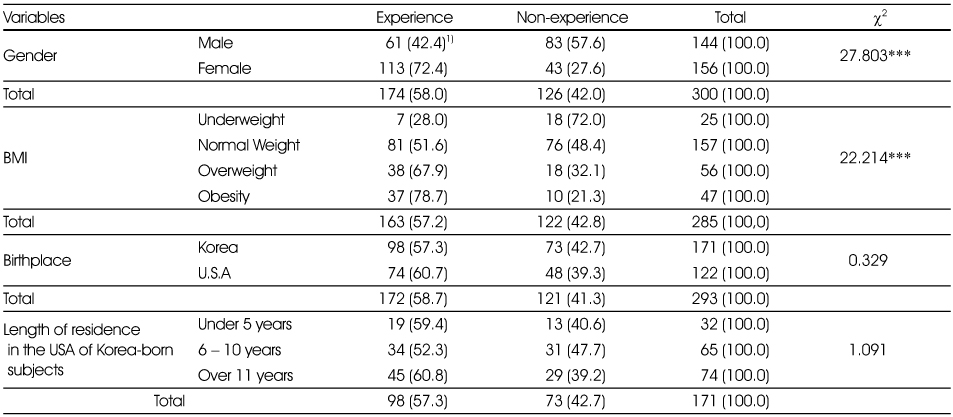
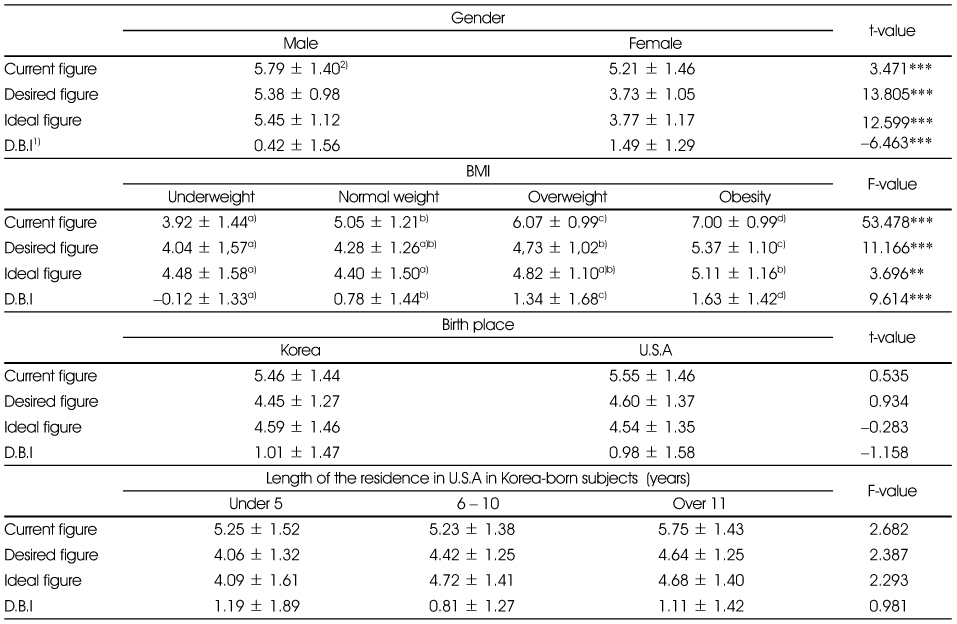
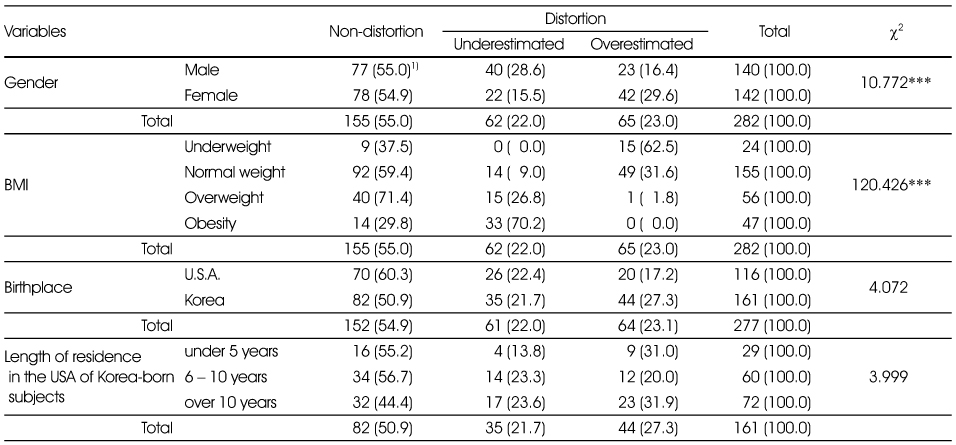
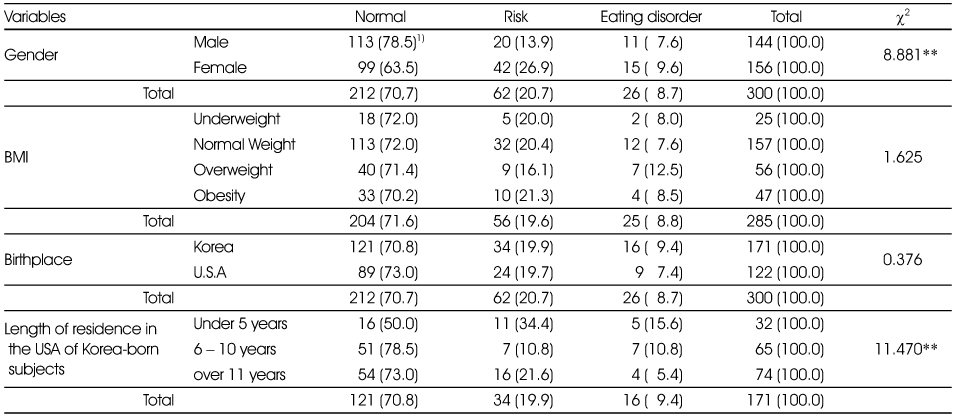
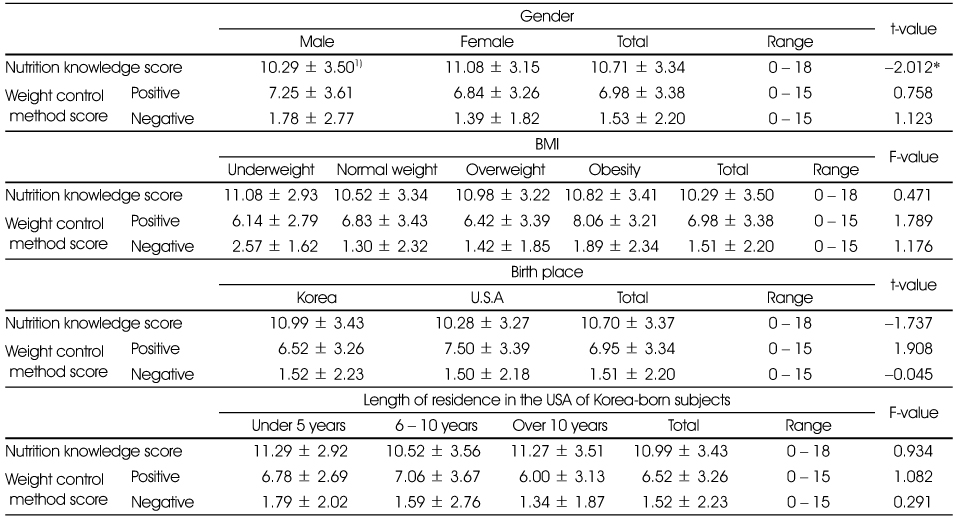
 PubReader
PubReader Cite
Cite


